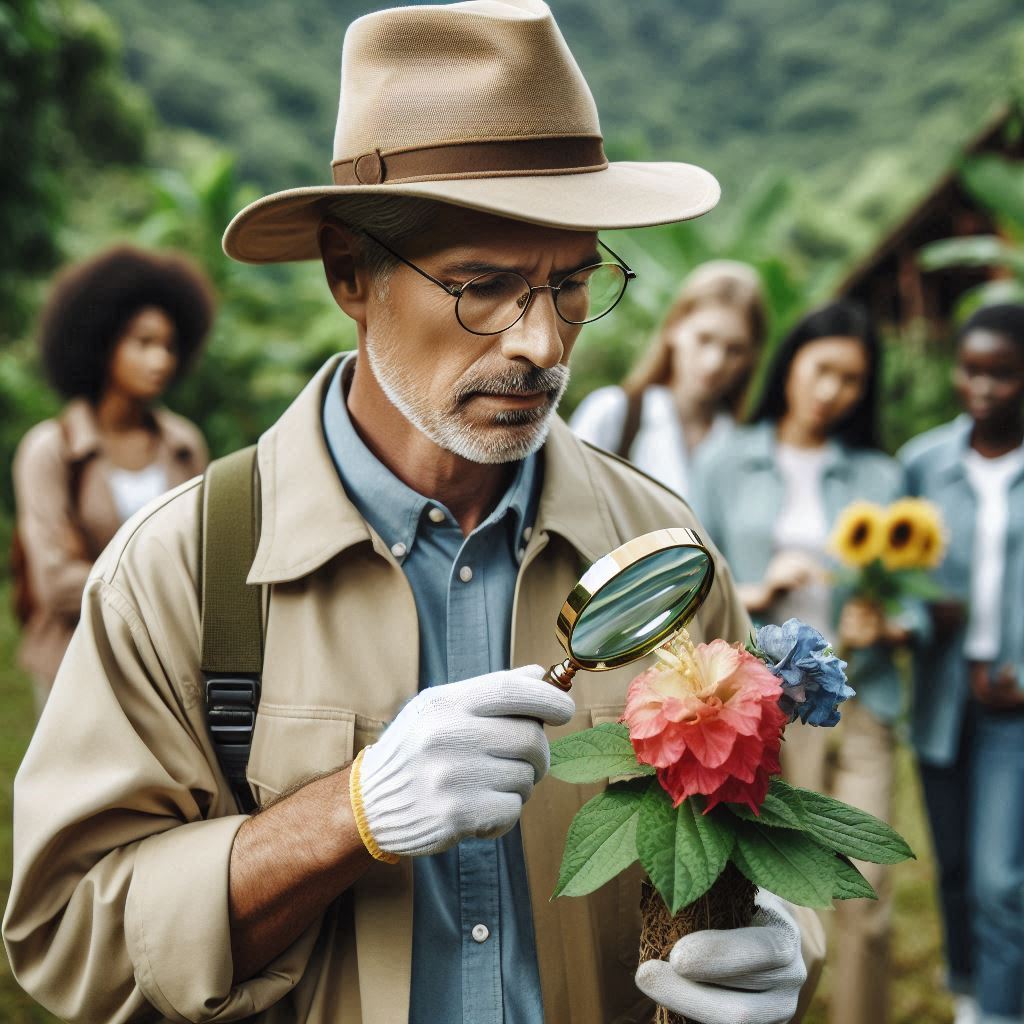Introduction
Grant writing is the structured process of crafting a formal proposal to secure funding from institutions, government agencies, or private organizations.
It involves articulating research goals, explaining methodologies, outlining expected outcomes, and justifying why the project is worth funding.
A well-written grant proposal guides potential funders through the researcher’s vision.
It highlights the societal or scientific impact their work can achieve.
For botanical researchers, grant writing holds tremendous importance.
Conducting botanical research often involves a wide range of costs, from fieldwork and laboratory equipment to specialized software and personnel.
Securing grants allows researchers to obtain the resources they need to study plants, ecosystems, and biodiversity.
Without sufficient funding, botanical researchers may struggle to carry out the full scope of their research.
This is particularly true for large-scale studies that involve extensive data collection, travel to remote research sites, or access to advanced laboratory technologies.
Grant writing is, therefore, essential not only to advance scientific inquiry but also to ensure that research projects remain competitive and feasible.
Understanding the Grant Application Process
Securing funding for botanical research can be a challenging but essential step for advancing in the field.
Grants offer essential financial support for conducting research.
They also help researchers attend conferences, gain training, and buy equipment.
For botanical researchers, understanding the grant application process and knowing where to find relevant opportunities is key to success.
In this guide, we will explore the various types of grants available for botanical research and offer comprehensive tips on how to identify and apply for them.
Types of Grants Available for Botanical Research
Botanical researchers have access to several types of grants, each designed to meet specific needs within the field.
These include:
Research Grants
Research grants are among the most sought-after and commonly awarded types of funding in botany.
They provide financial support for specific research projects, whether focused on plant biology, ecology, conservation, or another botanical discipline.
These grants often cover expenses related to fieldwork, lab work, personnel, and other research-related costs.
Securing a research grant often requires a detailed project proposal that outlines the study‘s objectives, methods, and expected outcomes.
Travel Grants
Travel grants are essential for researchers who need to attend conferences, workshops, or seminars to present their findings or collaborate with other scientists.
These grants can cover transportation, accommodation, registration fees, and other expenses related to attending scientific gatherings.
Travel grants are particularly useful for early-career researchers looking to expand their professional network and gain exposure to the latest developments in botany.
Equipment Grants
Some botanical research requires specialized equipment, which can be costly.
Equipment grants are designed to help researchers purchase the tools they need for their work, such as microscopes, spectrometers, or field equipment.
These grants may also fund maintenance or upgrades for existing equipment.
When applying for equipment grants, clearly demonstrate why the equipment is essential for your research project.
Highlight the potential impact the equipment will have on the study‘s outcomes.
Training Grants
Continuous learning is a significant aspect of staying current in the botanical field.
Training grants provide support for researchers to gain new skills, attend specialized courses, or engage in professional development opportunities.
Training grants help researchers grow professionally by learning new analytical techniques and mastering data modeling.
They also enhance researchers’ research capabilities.
Tips on How to Search for Relevant Grant Opportunities
Once you‘ve identified the type of grant you need, the next step is finding opportunities that align with your research goals.
Here are some tips to help you navigate the search process:
Utilize Online Grant Databases
Several online databases provide comprehensive listings of available grants for researchers in various fields, including botany.
These platforms allow you to search for grants by category, funding amount, and eligibility criteria.
Subscribing to these sites or setting up notifications for new grant opportunities ensures that you stay informed of upcoming deadlines.
Join Professional Organizations
Professional botanical organizations like the Botanical Society of America (BSA) and the Society for Conservation Biology offer exclusive grants to members.
Joining these organizations connects you with researchers who share grant tips and insights.
You also gain access to funding information.
Membership often comes with additional benefits such as access to journals, conferences, and job postings.
Network with Fellow Researchers
Conferences, workshops, and seminars are prime venues for networking with fellow researchers who may be aware of grant opportunities.
Conversations with colleagues can lead to discovering lesser-known funding sources or collaborative grants.
Networking is also crucial for building relationships that may lead to joint research proposals, which are often more competitive in securing large-scale funding.
Consult with University Research Offices
Many universities have dedicated research offices that assist faculty and students in finding and applying for grants.
These offices often offer workshops on grant writing, proposal development, and funding searches.
Research offices can provide institutional funding, offering seed money for initial research phases.
This support helps before applying for larger grants.
Consulting with these offices ensures you have the support and resources necessary to navigate the application process.
Understanding the grant application process is essential for botanical researchers seeking to secure funding for their work.
Whether you‘re looking for research, travel, equipment, or training grants.
Knowing where to search and how to write a strong application can significantly increase your chances of success.
To find the right funding opportunities for your research, utilize online databases. Join professional organizations to access resources.
Network with peers for insights and connections. Consult university research offices for guidance and support.
Writing a compelling grant application is crucial for securing financial resources for your research.
Highlight the significance and impact of your work. This final step helps you advance in the field of botany.
Crafting a Strong Research Proposal
When it comes to applying for research grants as an aspiring botanical researcher, crafting a strong research proposal is key to securing funding.
A well-structured proposal not only articulates your research objectives but also demonstrates the significance of your work and your ability to conduct it effectively.
Below are some detailed tips and guidelines to help you communicate the importance of your research and detail the key components of a successful proposal.
Key Components of a Successful Research Proposal
- Title: Your proposal should begin with a clear and concise title that accurately reflects the focus of your research.
The title should encapsulate the essence of your study, making it immediately understandable to a diverse audience.
It should be engaging yet informative, hinting at the significance and scope of the research. - Abstract: Following the title, provide a brief summary of your research objectives, methods, and expected outcomes in the abstract.
This section should be succinct‘typically around 250‘300 words‘offering a snapshot of your proposal.
Aim to highlight the central question your research addresses, the methodology you will employ, and the potential implications of your findings.
The abstract often serves as the first impression, so make it compelling. - Introduction: In the introduction, clearly state the research problem you intend to investigate.
Provide necessary background information that contextualizes your study within the broader field of botanical science.
Explain the significance of your study, addressing why this research is needed and how it fits into current knowledge.
This section should establish the framework for your proposal, demonstrating a solid understanding of the topic and its relevance. - Research Objectives: Clearly outline the specific goals and aims of your research project.
These objectives should be measurable and achievable, guiding the direction of your study.
Consider framing your objectives using the SMART criteria: Specific, Measurable, Achievable, Relevant, and Time-bound.
This approach not only clarifies your aims but also provides a roadmap for your research journey.
Effectively Communicating the Significance of Your Research
- Highlight Unique Contributions: Emphasize the unique contribution your research will make to the field of botanical science.
Identify what sets your study apart from existing literature and how it will advance knowledge or practices within the discipline. - Address Knowledge Gaps: Clearly explain why your research is important and how it addresses a gap in current knowledge.
Articulate the questions that remain unanswered in the field and how your work will provide insights into these critical areas. - Demonstrate Potential Impact: Illustrate the potential impact of your research on the scientific community and society as a whole.
Discuss how your findings could influence policy, conservation efforts, or further research in the field, making a case for the broader relevance of your work. - Use Clear Language: Employ clear and concise language to effectively communicate your ideas and research objectives.
Avoid jargon whenever possible, and strive for clarity in your explanations.
Remember that your proposal may be reviewed by individuals from various backgrounds, so aim to make it accessible to a wide audience.
Tips and guidelines help you craft a strong research proposal.
A compelling proposal communicates the significance of your botanical research.
This approach increases your chances of securing funding for your project.
A well-prepared proposal not only serves as a roadmap for your research journey but also as a testament to your dedication and expertise in the field.
Read: Biology Ethics: Navigating Complex Issues in the US
Promoting Botanical Research Impact
Aspiring botanical researchers must showcase the potential impact of their work.
Highlighting the significance of research can attract funding and collaboration.
Funders seek projects that demonstrate clear benefits to society, ecology, or industry.
By effectively communicating impact, researchers can enhance their grant applications and increase their chances of success.
Importance of Showcasing Research Impact
- Attract Funding: Highlighting impact can lead to more financial support from grants and donations.
- Engage Stakeholders: Clear impact statements can attract interest from policymakers, educators, and community members.
- Influence Policy: Demonstrating research impact can influence conservation strategies and environmental policies.
- Increase Collaboration: Researchers who emphasize impact can foster partnerships with industry, NGOs, and government agencies.
- Enhance Visibility: Showcasing impact can improve a researcher‘s visibility in the scientific community and among the public.
Tips on Quantifying and Measuring Impact
Quantifying and measuring the impact of botanical research is essential for effective communication.
Use the following tips to enhance your research impact statements:
- Collect Data: Gather data throughout your research process.
Regularly update your metrics to reflect progress and results. - Engage Stakeholders: Collaborate with stakeholders to understand their needs.
This helps you measure the relevance and impact of your work. - Conduct Surveys: Use surveys to gauge public perception and understanding of your research.
This provides insight into its broader impact. - Highlight Case Studies: Present specific examples where your research has made a difference.
Case studies illustrate real-world applications and outcomes. - Use Visual Aids: Incorporate graphs, charts, and infographics to present data clearly.
Visual aids can make complex information more accessible. - Report on Outcomes: Share your findings in publications and reports.
Highlight how your research contributes to conservation and ecological understanding. - Share Success Stories: Use storytelling to communicate impact.
Personal stories resonate with audiences and showcase the human aspect of your research. - Build a Digital Presence: Maintain an online presence through blogs, social media, and websites.
Regularly share updates on your research impact to engage a broader audience.
By effectively promoting the impact of your botanical research, you can attract attention and support.
Showcasing the importance of your work helps ensure its relevance and longevity.
Focus on quantifying and measuring your impact to make your research stand out.
With these tips, aspiring botanical researchers can improve their grant writing and secure funding for their important work.
Read: Continuous Learning: Post-graduate Options for US Biologists
Transform Your Career Today
Unlock a personalized career strategy that drives real results. Get tailored advice and a roadmap designed just for you.
Start NowProfessionalism in Grant Writing
The Importance of Professional Formatting and Language
As aspiring botanical researchers, it is crucial to understand the significance of professionalism in grant writing.
Grant applications often serve as your first point of contact with potential funders, making the initial impression critical.
A well-crafted proposal can differentiate your work from countless others vying for the same funding.
Therefore, it is imperative to ensure that your proposal is meticulously organized, error-free, and written in a clear and concise manner.
Professional Formatting
Professional formatting plays a pivotal role in the overall perception of your application.
Consistency in fonts, headings, and margins throughout the document conveys attention to detail and respect for the funder‘s guidelines.
Use a legible font, such as Times New Roman or Arial, typically in 11 or 12-point size.
Establish a clear hierarchy with headings and subheadings to guide the reader through your narrative.
Avoid overly casual language or slang; instead, maintain a professional tone that demonstrates your expertise and credibility.
Language and Tone
The language used in your grant application is equally important.
Choose words that reflect your knowledge and understanding of botanical science while avoiding jargon that may alienate reviewers.
A professional tone should pervade your writing, showcasing your passion for your research while maintaining a level of formality that respects the grant-giving process.
Additionally, when communicating with potential funders, always address them respectfully.
Use appropriate salutations and adhere to any specific guidelines they provide regarding formatting and content.
Attention to Detail
Detail orientation is another critical aspect of professional grant writing.
Pay meticulous attention to details such as word count limits, submission deadlines, and any required attachments or supplementary materials.
Failure to adhere to these parameters can result in your proposal being dismissed, regardless of its content quality.
Overall, presenting your grant proposal in a professional and polished manner is essential for making a favorable impression and increasing your chances of success.
A well-formatted and clearly articulated proposal demonstrates your dedication to your research.
It also shows your commitment to professionalism.
Additionally, it reflects your understanding of the grant application process.
Suggestions to Make Your Grant Application Stand Out
To elevate your grant application and make it stand out from the competition, consider incorporating the following strategies.
- Articulate Your Research Goals and Objectives: Clearly articulate your research goals and objectives from the outset.
This demonstration of a clear understanding of the problem you are addressing will resonate with reviewers.
Highlight the significance of your research within the broader context of botanical science. - Showcase Your Qualifications and Experience: Your qualifications and experience are vital components of your application.
Showcase your expertise in botanical research by detailing relevant academic degrees, publications, and previous research projects.
If you have any relevant achievements or accomplishments, such as awards or recognitions, be sure to highlight those as well. - Include a Detailed Budget: A comprehensive budget is essential in demonstrating your fiscal responsibility and strategic approach to resource management.
Clearly outline how the grant funds will be allocated, breaking down costs into specific categories such as personnel, materials, equipment, and travel. - Incorporate Visuals: Visual aids such as graphs, charts, and images can significantly enhance the readability and engagement of your proposal.
A visually appealing proposal can leave a lasting impression on reviewers, making your application more memorable.
By implementing these strategies and emphasizing professionalism in your grant writing.
you can significantly increase your chances of securing funding for your botanical research projects.
Remember, a compelling grant application is not just about presenting your research.
It is also about communicating your passion and commitment to advancing the field of botanical science.
Your dedication to professionalism will resonate with reviewers and foster trust in your ability to carry out the proposed work.
Read: Essential Skills and Tools for Modern Chemists in America

Uncover the Details: Technological Advances in Immunology
Navigating the review process
Typical Review Process for Grant Applications
The review process for grant applications is a critical step in determining which projects receive funding.
Process typically involves multiple stages designed to ensure thorough evaluation and fair selection of proposals.
Below are the key steps involved in this process:
- Submission and Initial Screening: Once the application deadline passes, all submitted proposals are gathered by the grant administration team.
They conduct an initial screening to verify that each application meets the basic eligibility criteria outlined in the grant guidelines.
This includes checking for completeness, adherence to format requirements, and compliance with submission deadlines.
Proposals that do not meet these criteria may be disqualified at this stage. - Convene the Review Committee: After the initial screening, the grant committee convenes to initiate the review process.
This committee usually comprises experts in the relevant field, stakeholders, and representatives from the funding organization.
The committee members are responsible for evaluating the quality of the proposals and determining which ones align best with the goals of the grant. - Review Criteria Assessment: The committee evaluates each proposal based on predetermined criteria.
These criteria include relevance to funding priorities, project feasibility, and innovation.
They also assess budget justification and the project team’s qualifications.
The evaluation uses scoring systems or ranking methods for structured comparison.
Committee members consider the proposed project’s potential impact on the target population or field. - Shortlisting Applicants: Following the initial review and assessment, the committee will create a shortlist of promising applications.
This shortlist typically consists of those proposals that scored the highest according to the review criteria.
The committee may choose to invite these applicants for further clarification or to request additional information.
This systematic review process ensures funding awards for projects that demonstrate quality and innovation.
It also aligns closely with the grant’s objectives.
Strategies for Responding to Reviewer Feedback
Receiving feedback from grant reviewers can be both a challenging and enlightening experience.
Responding effectively to this feedback is crucial for improving your proposal and increasing your chances of future success.
Here are some strategies to consider:
- Approach Feedback Constructively: Begin by adopting a constructive mindset when reviewing the feedback.
Understand that the comments are intended to help you enhance your proposal.
Set aside any emotional responses and focus on the suggestions provided. - Careful Reading of Comments: Carefully read and analyze each comment or suggestion made by the reviewers.
Pay attention to specific criticisms and take note of any recurring themes or areas that need improvement.
Identify both strengths and weaknesses highlighted by the reviewers to gain a balanced view. - Create a Plan of Action: Develop a detailed plan of action to address the feedback.
Outline specific changes you will make to your proposal, whether they involve revising sections for clarity, providing additional data, or altering the project scope.
Consider prioritizing the most significant critiques that could enhance the proposal’s overall quality. - Revise the Proposal: Make necessary revisions based on the feedback.
This may include clarifying objectives, adjusting methodologies, or refining the budget.
Ensure that your revisions align with the reviewers’ suggestions while also maintaining the integrity of your original vision. - Seek Input from Colleagues: Before resubmitting your proposal, seek input from colleagues, mentors, or individuals with experience in grant writing.
They can provide valuable perspectives on your revisions and help identify any remaining weaknesses or areas for improvement.
Approach reviewer feedback with an open mind and a strategic plan.
This approach can significantly improve your proposal.
It also increases your chances of securing funding in future applications.
Read: The Role of Chemists in US Environmental and Sustainability Efforts
Delve into the Subject: The Process of Excavation: Tools and Techniques
Ensuring Compliance with Grant Regulations
In this article, we will explore common grant regulations for botanical researchers.
We will also provide practical tips to help you stay organized and meet compliance requirements.
By familiarizing themselves with these elements, researchers can boost their chances of securing funding.
This funding will help bring their innovative ideas to life.
Common Grant Regulations for Botanical Researchers
Submission Deadlines
Timeliness is of the essence in the world of grant applications.
Funding agencies typically impose strict deadlines for submissions, and missing these deadlines can result in automatic disqualification from the grant process.
Researchers must be diligent in managing their time effectively to ensure that all application materials are prepared and submitted well in advance of the deadline.
Setting personal deadlines ahead of the official submission date can provide a buffer to accommodate unforeseen circumstances.
Budget Restrictions
Most funding agencies provide specific budget guidelines that researchers must follow to allocate funds appropriately.
These guidelines often outline allowable expenses, including salaries, equipment, travel, and other project-related costs.
It is essential for researchers to carefully review these restrictions and construct a budget that aligns with the funding agency’s expectations.
A well-structured budget not only demonstrates financial responsibility but also enhances the credibility of the research proposal.
Reporting Requirements
Once a grant is secured, researchers must keep track of milestones and submit progress reports as mandated by the grant provider.
These reports typically require researchers to outline their achievements, challenges encountered, and any adjustments made to the original project plan.
Maintaining organized records and documenting progress during the research process will facilitate reporting.
This approach also helps build a positive relationship with the funding agency.
Tips for Ensuring Compliance with Grant Regulations
Successfully navigating the complexities of grant applications requires careful organization and strategic planning.
Here are some tips for aspiring botanical researchers to stay organized and meet compliance requirements when applying for grants:
Showcase Your Business Today
Reach thousands of readers actively exploring professional services. Publish your business profile and grow your audience now.
Publish Now- Create a Detailed Timeline: Developing a comprehensive timeline can be a game-changer in managing grant applications.
Plot out key deadlines, milestones, and tasks associated with each stage of the grant application process.
This visual representation will help researchers stay on track and ensure timely submission of all necessary materials. - Use a Grant Management System: Investing in a grant management system boosts efficiency.
It helps organizations track and manage grant applications effectively.
These tools help researchers organize documents, monitor deadlines, and streamline communication. - Establish Clear Communication Channels: Maintaining open lines of communication with funding agencies is crucial.
Researchers should not hesitate to reach out for clarification on any doubts or to seek guidance on specific requirements. - Seek Professional Advice: Consulting with grant writing experts or mentors who have experience in securing funding can provide invaluable insights.
Researchers can enhance their application strategy with expert assistance.
They can receive feedback on their proposal drafts.
Experts can share best practices to boost their chances of success.
Aspiring botanical researchers can boost their chances of securing funding by following these grant regulations.
Implement these tips to enhance your funding prospects for research projects.
Compliance is not just a bureaucratic hurdle; it is the foundation for successful research endeavors.
Researchers who understand and adhere to grant regulations can focus on their scientific objectives.
Uncover the Details: Certifications Needed for Soil Scientists
Conclusion
Effective grant writing is crucial for aspiring botanical researchers.
Securing funding can propel your research projects and help you achieve your academic goals.
Start by clearly defining your research goals and objectives, as this clarity will guide your entire application process.
Develop a strong narrative that highlights your project‘s significance and potential impact on the field of botany.
Clearly explain how your research addresses critical issues or gaps in knowledge.
Tailor each proposal to align with the funding agency’s mission and priorities.
Gather supportive data and compelling visuals to enhance your application.
Well-chosen graphs, images, and tables can convey complex information more effectively than words alone.
Additionally, including a budget that clearly outlines how funds will be used is vital for transparency and credibility.
Remember, grant writing is a skill that improves with practice.
Even if you face setbacks, persistence is key.
Start your grant writing journey today! Your research can significantly impact botany.
Pursue the funding to bring your ideas to life.
Don‘t hesitate to take that leap!
[E-Books for Sale]
The Big Book of 500 High-Paying Jobs in America: Unlock Your Earning Potential
$19.99 • 500 High-Paying Jobs • 330 pages
Explore 500 high-paying jobs in America and learn how to boost your career, earn more, and achieve success!
See All 500 High-Paying Jobs of this E-Book
1001 Professions Without a Degree: High-Paying American Jobs You Can Start Now
$19.99 • 1001 Professions Without a Degree • 174 pages
Discover 1001 high-paying jobs without a degree! Unlock career tips, skills, and success strategies for just $19.99!




